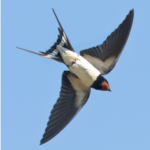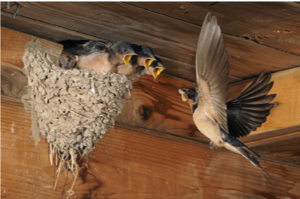- Appearance: blue backs, long wings, wings and tail end in black feathers, light brown bellies, only North American swallow that has forked tail; males (left) have cobalt blue backs with white patches, red faces; females (right) have blue-green backs, light brown faces, shorter tails
- Length: 6-8 inches (about .5 foot)
- Wingspan:11-13 inches (about 1 foot)
- Status:most common and widespread swallow species in the world
- In Eastern Hemisphere, barn swallows mostly have white bellies
- In many parts of the world, having a barn swallows nest on one’s property is considered a sign of good fortune
- Stories are told that Barn Swallows got their forked tails because they stole fire from the gods to give to the people, and their central tail feathers were shortened when they were burnt off by wrathful deities
- In mid-1800s, hunting of barn swallows for feather trade prompted George Bird Grinnell’s 1886 editorial that led to the founding of the first Audubon Society
- Habitat

- Adapt to any open area: estuaries, marshes, grasslands, lakes, ponds, riverbanks, beaches, meadows, agricultural fields, fields for parks and sports, etc.
- Humans have helped barn swallows maintain and even expand their range
- Avoid extremely dry areas, unbroken forest, or dense urban areas
- Can be found seasonally across North and South America
- Diet
- Forage on the fly, may form flocks with other swallows
- Flying insects, including beetles, bees, wasps, ants, butterflies, moths, mosquitos; favorite prey is flies
- Tails add extra maneuverability when chasing prey, also used to attract mates
- Prefer to catch a few large insects as opposed to attacking a swarm of small insects
- Encouraging barn swallows to nest near your home reduces your need to use chemical bug sprays
- Eat pebbles, grit, shells to possibly add calcium to diet or help with digestion
- Migration
- Spring migration begins anywhere from January to May
- Travel to breeding grounds across the U.S. and in the southern half of Canada
- The farther a barn swallow has to migrate, the earlier it begins its migration
- Fall migration begins anywhere from June to July
- Overwinter in Central and South America
- In Americas, migration distance is up to 5,500 miles
- Some populations that live in Mexico are nonmigratory
- In Eastern Hemisphere, barn swallows breed in Eurasia and overwinter in Africa
- Known to fly in straight bursts, taking sudden turns and dives, rarely glide
- Average flight speed is about 24 mph, top speed is about 45 mph
- Spring migration begins anywhere from January to May
- Nesting
- Historically nested in caves throughout North America, but now almost always nest on manmade structures
- The only barn swallow population that still nests in caves in North America uses the Channel Islands off the California coast
- Barn swallows have many different mating patterns – some find new mates each year, some pairs mate for several years, some find multiple mates
- Barn swallows often nest in large colonies of up to several dozen nests
- Breeding pairs fly over landscape to explore multiple potential nesting sites
- Prefer eaves, rafters, and cross beams of barns, sheds and stables, as well as the undersides of bridges, wharfs, and culverts
- Will use nests from previous years unless destroyed or infested by parasites

- Male and female collect mud, mix it with grass, sculpt cup-shaped nest, line with feathers
- Can also build nest vertically, in which case nest is a semicircle
- Average brood is 3-5 creamy white eggs with black, brown, or lavender markings
- In areas with plenty of food, or if the first brood dies, may lay another set of eggs
- Males extremely territorial, chase other male swallows, may dive bomb people
- Both parents feed offspring, and sometimes mature offspring from previous broods help parents care for the nest and the chicks
- Fledglings learn to fly after 18-23 days, mature after 1 year
- All juveniles look like females at first, and their tails are short and lack forking
- Young do not return to nesting site where they were raised, disperse to new colonies
- Average lifespan is about 4 years, but the oldest barn swallow was about 16 years old
- Historically nested in caves throughout North America, but now almost always nest on manmade structures






